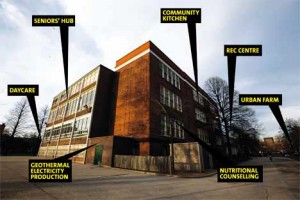TDSB enrolment figures excludes adult programs, community groups
 With 130 “underutilized” Toronto schools on a list for possible closure, critics say the province’s method for determining whether they are at capacity fails to capture the reality in many of the city’s schools.
With 130 “underutilized” Toronto schools on a list for possible closure, critics say the province’s method for determining whether they are at capacity fails to capture the reality in many of the city’s schools.
In response to a demand by the province to address declining enrolment, the Toronto District School Board released a list Wednesday of 130 schools that are operating at below 65-per-cent capacity – the province’s threshold for whether a school is “underutilized.”
“It’s bogus, because many of the schools are being used in other ways for educational purposes,” said Campaign for Public Education co-ordinator Stephen Seaborn, an advocacy group made up of parents and teachers.
The province’s formula measures each school’s enrolment as the total number of public-school students, but does not include others in the community who use the school, such as adult education programs or members of community groups who lease space.
Nilani Logeswaran, a spokeswoman for Education Minister Liz Sandals, said the ministry does recognize some of these uses – like adult education – but that funding for that is provided through a separate grant.
And in measuring capacity, the province looks at the number of students who could possibly fit in the total space of a school – meaning such non-classroom areas as cafeterias, libraries and gymnasiums are counted as empty space.
“The ministry has a really skewed way of listing capacity,” TDSB trustee Chris Glover said in an interview.
“If you’re an adult, you don’t count as a student.… if we’ve got a school that’s leased out to government agencies, or portions of schools to community agencies, that’s not considered space that’s utilized.”
The city’s chief planner, Jennifer Keesmaat, meanwhile, said the province needs to recognize that schools fulfill a greater purpose within their communities than simply classrooms for school-aged children – for example as daycares, gathering places for seniors and greenspace for neighbourhoods.
“The challenge is that I think we have a funding approach at the provincial level that is difficult to rationalize with a view of schools as a broader community amenity, as opposed to simply serving school-aged children,” she said.
Trustee Tiffany Ford, meanwhile, called the province’s system of measuring capacity “outdated.”
She said in an e-mail that she was “shocked” to see a school in her ward, Emery Collegiate, on the province’s list at 45-per-cent capacity.
“I was just in that school and I could hardly walk through the halls because it was so crowded,” she said.
Part of that reason, TDSB trustee Pamela Gough said, is that the province’s measurements do not take into account each school’s individual architecture or use of space.
Ms. Gough pointed to an old elementary school in her Etobicoke-Lakeshore ward that was built originally as a high school.
With its narrow hallways and early 20th-century design, she said, the school feels “absolutely crammed. The lunchroom is phenomenal. They have to have the kids come in for lunch in shifts.
“You can’t have them all in one room at one time.”
Yet, she said, the list only shows the school at 80-per-cent capacity.
Ms. Gough said she also questions the province’s use of the 65-per-cent figure as a threshold.
“As far as I know, it was just a figure they pulled from thin air,” Ms. Gough said.
Ms. Sandals’ spokeswoman said that the 65-per-cent figure “is a rate that is used by the ministry to provide operational and renewal funding to support schools that are operating below capacity.”
Ann Hui Globe & Mail Jan 30, 2015



